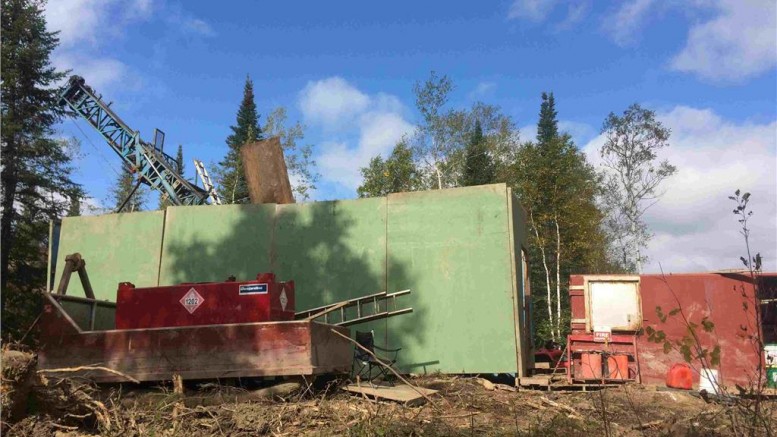VANCOUVER — Premier Gold Mines (TSX: PG; US-OTC: PIRGF) is taking a new approach to exploration at its past-producing Hasaga gold property in the prolific Red Lake mining district of northwestern Ontario, and Ewan Downie, president and CEO, thinks the company could be onto something big.
“The drills are turning and we’ve made what we think is a significant open-pit style discovery,” he tells The Northern Miner during a phone interview.
The company revitalized exploration at Hasaga after acquiring the dormant property from Goldcorp (TSX: G; NYSE: GG) in February, and Downie says results from the property’s Central zone are building a robust target.
The reported drill holes hit widespread lower-grade gold mineralization around structures within the Dome Stock — a large granitic intrusive unit in the heart of the Red Lake camp.
Intercepts included 0.94 gram gold per tonne over 306 metres, and 0.52 gram gold over 306 metres, within 500 by 400 metres of surface mineralization that is open in all directions.
Downie says results from drilling this year have encouraged the company to double the drill budget to 40,000 metres, and more assays are expected over the coming weeks.
“Most companies that go to the Red Lake camp are in search of elusive high-grade zones that are one of a kind, and finding them can be difficult,” he says. “So we believe there’s a lot of overlooked opportunity in the Red Lake camp for broad, low-grade, open-pittable mineralization, and that’s what we’re after.”
Deposits in the district are hosted within the Red Lake greenstone belt, which dates back 3 billion years to the inhospitable Archean eon — a time when the earth’s crust was warped by extreme temperatures, variable chemistries and vigorous tectonism.
During that time, a sequence of volcanic and volcaniclastic rocks called the “Balmer” assemblage was tilted by an episode of intense deformation and eroded for 200 million years.
The weathering draped a package of conglomerates discontinuously across the rocky paleo-surface, while plutonism from below — along with the active tectonism — introduced coffers of gold into the crust.
Once the main surge of mineralization wrapped up, volcanoes towered the horizon once again and the gold-injected land was covered by the mafic flows belonging to the Confederation group.
In the Red Lake district, most gold deposits in the district — such as Goldcorp’s Red Lake mine and Pure Gold’s (TSXV: PGM; US-OTC: LRTNF) Madsen project — occurs within 500 metres to 1 km from the unconformity, according to a 2003 research report from the Geological Survey of Canada.
The report says the unconformity is built upon large-scale tectonism and magmatism that concentrated gold mineralization, so exploring the contact increases the chances of making a discovery that’s nearer to surface.
“We’re in a great position at Hasaga because we’re near that unconformity,” Downie says. “Our work has also identified a north-trending regional structure that may influence gold mineralization, so we’re planning drill trials.”
The other target on the property — the Porphyry zone — will also have its share of drill holes this year. The work will target lower-grade gold halos around the past-producing Hasaga and Howey underground mines, which historically produced 640,000 oz. gold at grades of 4.9 grams gold.
Downie adds that Premier considered Hasaga as an acquisition target after it transformed the Hardrock project, 2 km north of the town of Geraldton, Ont., from a historical underground gold operation into a robust open-pittable deposit, with 4.9 million indicated oz. gold.
The indicated resource is within 83.9 million tonnes of open-pittable material at 1.47 grams gold, and 5.2 million tonnes of underground material at 5.4 grams gold (using a 0.5-gram-gold and 3-gram-gold cut-off for open pit and underground operations).
Premier hooked up with gold miner Centerra Gold (TSX: CG; US-OTC: CAGDF) in February, and the fifty-fifty joint-venture partners are working towards a resource update and feasibility study for the project by late 2015, or early 2016.
Downie says partnerships “spread the risk and the money we need to spend to advance our projects,” but adds the company is in a “unique” financial position relative to its peers, toting $80 million of cash in the bank.
Another collaboration would be Premier’s 40% stake in Barrick Gold’s (TSX: ABX; NYSE: ABX) South Arturo mine in Nevada, which could quickly launch the explorer to producer status and deliver the partners US$85 million in free cash flow next year.
Premier is also advancing its wholly owned McCoy-Cove gold project in Nevada’s prolific Carlin trend, and its 44% owned Rahill-Bonanza gold project in the Red Lake mining camp with Goldcorp.
“Few companies with single assets achieve long-term success,” Downie notes. “We think we’ve done an outstanding job securing some of the best projects, in some of the best camps in North America.”
Premier shares have traded within a 52-week range of $2.20 to $2.34, and closed at $2.31 at press time. The company has 170.7 million shares outstanding for a 394.3-million market capitalization.


Be the first to comment on "Premier’s Downie bullish on Hasaga in Red Lake"